Car Speaker Enclosure Design
When a speaker moves forward, air in front of the cone is compressed. At the same time, air in back of the cone is rarefied (stretched). If there is a pathway for the compressed air to get behind the cone, it will do so. This process reduces the amplitude of the soundwave. It is therefore necessary to use some type of enclosure, in order to keep the soundwaves from cancelling each other out.
Infinite Baffle
An infinite baffle design is defined as an enclosure that contains a greater volume of air than the Vas of the driver. An infinite baffle system can easily be applied to an automobile. This is accomplished by mounting the speakers on a board and using the trunk of the vehicle as the other walls of the enclosure. It is important that there be no leaks that would allow air to move from the front to the back of the cone. Look for speakers where the Qts is greater than .6, and a Vas lower than the volume available when selecting a woofer for an infinite baffle system.
Sealed Enclosures
Diagram 1 - Sealed Enclosure
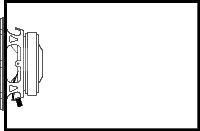
When the volume of air within a sealed enclosure is less than the Vas of the driver, the air trapped within the enclosure acts as an acoustic spring that adds to the restoring force of the speaker. This system is called acoustic suspension, also referred to as a sealed enclosure. Acoustic suspension systems are relatively easy to design and construct. The output rolls off at 12dB per octave below the point where output is down 3dB from midband (F3). A well designed sealed enclosure will exhibit smooth frequency response with excellent cone control at sub-bass frequencies. When selecting a woofer for a sealed enclosure, look for Qts to be between .3 and .9, with a low Fs (below 40Hz).
Vented Enclosures
Diagram 2 - Vented Enclosure
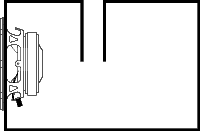
Vented enclosures are also known as ported, bass reflex, tuned, or tuned ported. A vented enclosure is essentially a sealed enclosure with an extra opening that allows the back wave to interact with the front wave. By changing either the length or surface area of the opening, we change the tuning frequency of the enclosure.
This system offers some performance advantages and disadvantages over a sealed enclosure. The advantages are, for a given enclosure volume, deeper bass extension or higher output. Another advantage is that near the tuning frequency, almost all output is from the vent so cone movement is controlled to the point of almost no movement. The disadvantage is that below the tuning frequency, the speaker no longer has the restoring force of the air in the enclosure, and therefore the cone acts as though it is in free air.
When selecting a woofer for a vented enclosure, look for speakers with a Qts in the range of .1 to .40, as well as a relatively low Fs (30-40 Hz).
Bandpass
Diagram 3 - Single Reflex Bandpass
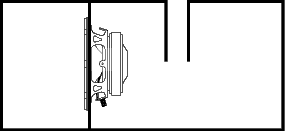
The bandpass systems, also referred to as 4th, 5th, 6th, 7th,8th... order enclosures can best be described by referring to them as single or dual reflex.
A single reflex system has one side of the speaker in a sealed enclosure and the other side in a vented enclosure. The benefits of this type of system are controlled cone excursion at low frequencies, and the ability to sacrifice efficiency for deeper bass or vice versa. The frequency response of the single reflex system is controlled by the enclosure volumes and tunings.
Due to the fact that all the sound from this type of enclosure is produced by the vent, sound quality may not be as good as that of a properly designed sealed or ported enclosure. However, there are times when bandpass enclosures are the best choice to use. In a sedan application, bandpass enclosures are often used due to the inability to have multiple drivers mounted in the rear deck. In a limited space situation, efficiency can be sacrificed to gain deeper bass extension. In a situation where ultimate SPL is the goal, you can sacrifice bass extension, and enclosure size to produce a very efficient enclosure. Efficiency gains in the range of 5-10dB are not uncommon! As with any enclosure design, there is no free lunch. As you change one parameter to gain another, many times sound quality is degraded as well.
Diagram 4 - S values
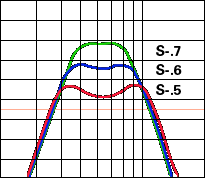
The frequency response in the pass band of a single reflex enclosure can be described with an “s factor”. S values that are of interest to us fall between .7 and .4. Values beyond this range either have peaky response, or poor sonic quality. An s of .7 refers to the flattest pass band available, where an s of .4 refers to the widest useable pass band.
A dual reflex enclosure can be described as a speaker with a ported cabinet on both sides. This system has the advantage of making use of both the front and the back wave of a speaker, and can attain great efficiency. However, like a vented enclosure, when operating below the tuning frequency of the enclosure, the driver may move beyond its excursion limitations. Combine this with the fact that all information is produced by the ports, so, we can’t hear the distortion until it is too late.
Diagram 5 - Dual Reflex Bandpass
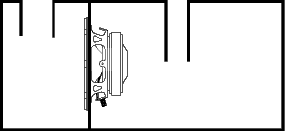
Multiple Drivers
It is often possible to attain better sound quality and higher output for a given airspace by using multiple smaller speakers rather than a single large one.
When designing an enclosure that will use multiple speakers, be sure that you are doubling the air space that you would have used for a single driver. If the speakers will be given the same signal, a divider is not necessary. If the speakers will be operated by two different signals, be sure to use a divider to separate the two enclosures, or cancellation will result.
Diagram 6 - Multiple Driver Enclosure

Isobaric
By combining two woofers to act as one, either by mounting them gasket to gasket, or gasket to magnet or magnet to magnet, we create an isobaric system. An isobaric system acts as one speaker, but requires an enclosure volume that is half of what one singular driver would take. The output capability of this system is limited to what a single speaker would be in a cabinet of twice the size of the isobaric system. The reason that an isobaric system requires only half of the enclosure volume is that the Vas is half of the single driver. This is due to having two suspensions on the same diaphragm.
Diagram 7 - Multiple Driver Enclosure

The halving of enclosure size does come at a cost. The isobaric system is 3dB less efficient than that of a single driver in an enclosure of twice the size. This means that to get the same output as one driver, you must double the applied power. Providing that you have enough power, two isobaric systems, which would take up the same amount of space as one single woofer, would have 3dB more output due to the increase in cone area. This can be used to your advantage when standard enclosures will not give enough SPL, by quadrupling the input power and quadrupling the number of drivers, you can attain 6dB more output.
